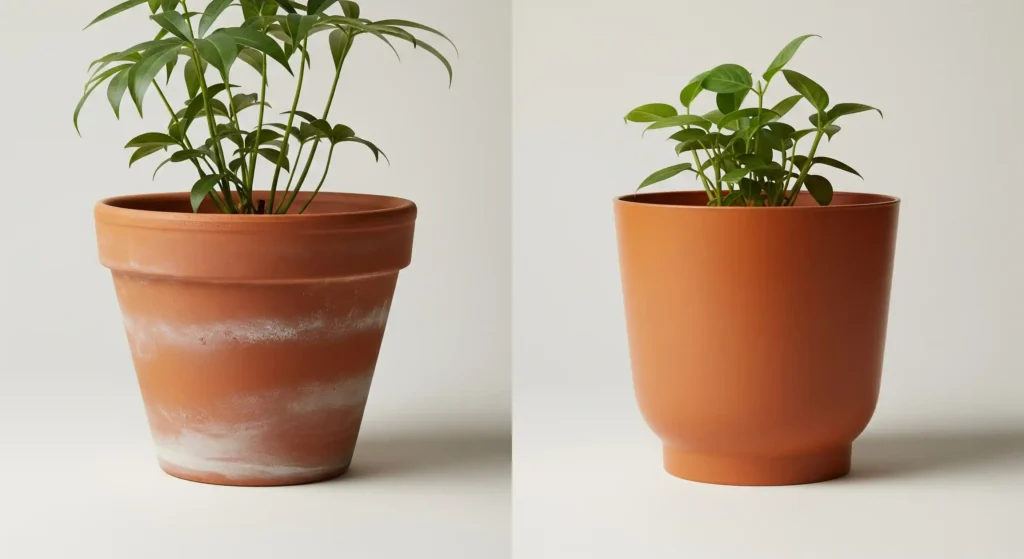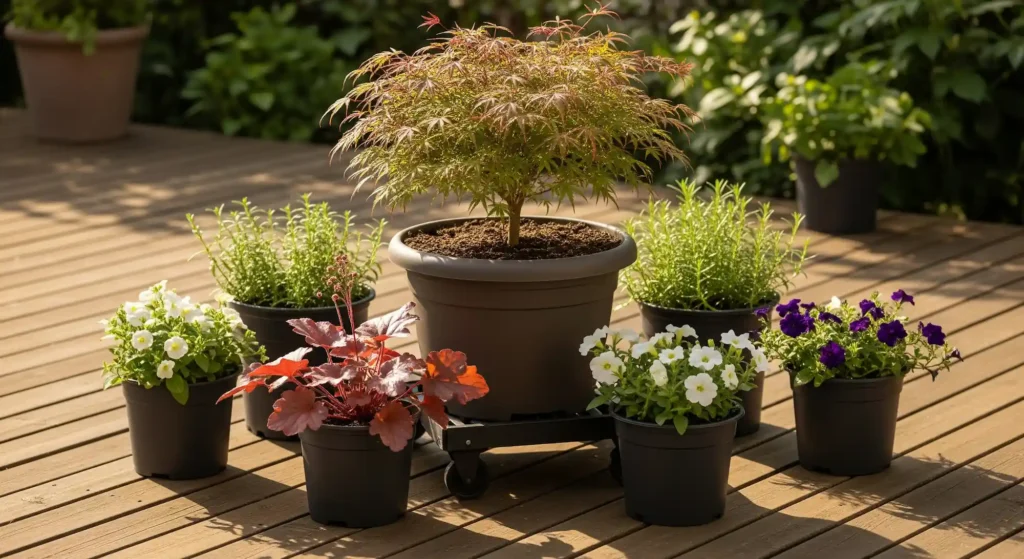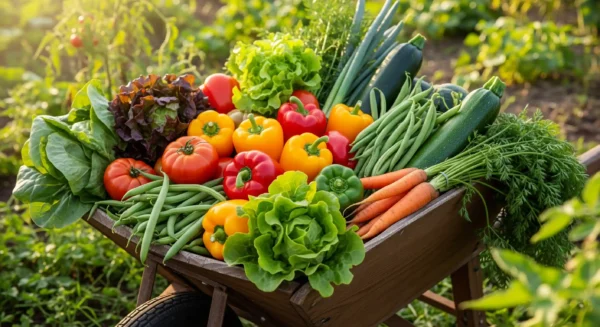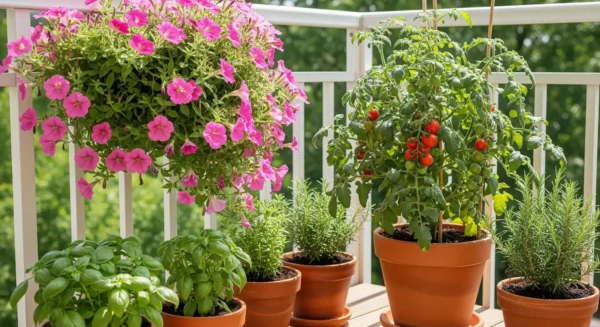An Effortless Oasis: The Complete Guide to Designing and Moving Your Container Garden
Ever planted a lovely, spreading tomato plant in a large ceramic pot, only to find in the thick of a July hot that transferring it into the shade is a job fit for a professional weightlifter? Each of us has visited there. I can’t tell you how many times I have done that back-straining shuffle around my patio, worrying I might break one of my favorite pots or thinking of moving day. If I gave you the true key to a mobile, flexible garden, almost nothing had to do with raw force.
You see, from the very start, building mobility into the basis of your container garden will help you design and move it with great simplicity. The way one thinks completely changes. The answer lies on good planning rather than just lifting more. It’s about selecting the correct materials and applying basic, intelligent techniques before you ever add a scoop of dirt, transforming your heaviest, most awkward pots into smoothly gliding elements of your outdoor environment.
Ignorance of the grunting and groaning. This book will help you to totally rethink container gardening. I’ll be sharing with you the brilliant design decisions I discovered over years of work, the must-have (and shockingly reasonably priced) tools I swear by, and the detailed methods that will make your garden as wonderfully movable as it is useful. All set to open a world of simple rearrangement and save your back during the process? Now let us begin.
Before the Dirt: Three Pillars of a Really Portable Garden
Let’s start with the foundation before you even consider that bag of potting mix. Three pillars of wise decisions define a really mobile garden. The difference between the smooth glide and the back-breaking drag is getting these perfect from the start.
First pillar: The pot itself—reevaluating your container selection
Though I adore the traditional, rustic beauty of a terracotta pot as much as anyone, let’s be honest: it weights a lot once it’s loaded with damp soil. The first, and most important, choice you may make is selecting light-weight materials. For almost a quarter of the weight, modern pots fashioned from fiberglass, premium resin, and other composites can offer you that same stone or ceramic look. And don’t undervalue fabric grow bags. They couldn’t be more easy to move around, are wonderfully light, and improve root health.
This is a great tip of mine for when you simply can’t resist a gorgeous, weighty ceramic pot: don’t plant straight in it! Treat it as a decorative cachepot—a fancy name for a decorative outer pot. Arrange your plants in an inexpensive, light-weight plastic nursery pot that fits within. This manner, you simply lift the light inner pot out when it comes time to relocate and have the lovely appearance without the weight.
Second pillar: the filling—lightening your soil
Regarding weight, did you realize not all of your pots require heavy soil to be completely filled? Filling the bottom third with a lightweight, space-taking material may greatly lighten the weight for particularly large and deep planters—that is, those massive, striking pots you might place a little tree in. This is the trick of an ancient gardener! Great options are sealed plastic water bottles, old nursery pots flipped upside down, or packing peanuts—the plant-safe starch type; but, if you use styrofoam, arrange it in a mesh bag for simple removal later.

Now, a major word of caution: This method is intended for very deep pots where the plant’s roots won’t require that bottom room for years. For plants with shallow roots or annuals, it’s ideal. This should not be done in a tiny or medium pot or for anything like a carrot that needs to grow deep. Give your plants the root room they actually require.
Pillar Three: The Foundation—The Key to Perfect Gliding
Alright, so you have selected a smaller pot and might have even employed a smart filler to lighten it. That half the struggle is what it is. But the secret magic—that which will really transform your gardening life—occurs at the root. The last piece of the jigsaw that transforms a still object into a dynamic, moveable component of your garden is what your pot sits on. Here we learn the tools and methods to enable you to gently push your pots around in gliding motion.
Learning the Art of a Mobile Container Garden: The Effortless Movement
Here is where we get the useful information—the real tools and methods allowing you to reorganize your garden at whim. Investing in one or two of these basic tools will pay for itself a hundred times over in reduced effort and a healthy back.
Your first tool is the modest plant caddy.
If you only follow one item of advise from this page, let it be to get a nice plant caddy. The one best purchase a container gardener can make is a heavy-duty, weather-resistant plant dolly with lockable wheels. You set it under your pot before you fill it; from that point on, your large planter can be nudged gently.
Don’t just grab the least expensive item you find while shopping.
- Search for a large load capacity so that it can manage more weight than you may possibly need.
- Examine the wheel materials; on surfaces like wood decks, rubber wheels are quieter and smoother than hard plastic ones.
- Look for locking wheels most critically as well. Your valuable Japanese Maple sliding off your balcony in a windstorm is unacceptable!
The “Pot Lifter’s” Toolkit: Simple Machines to the Rescue
A caddy won’t aid you yet for those already-planted pots that are firmly seated on ground. It’s at this point you call in reinforcements.
- Pot Mover Straps are really great. Usually, you work under the pot from opposing sides with a set of two heavy-duty straps. Then, by applying leverage rather than simply strength, two people can raise the heaviest, most awkward pots with amazing simplicity. It really serves as a back-saver.
- If you have a lot of big pots or are considering a move, a compact convertible hand truck will revolutionize things. You may wheel pots around using it as a flat dolly or tip and move pots upright. One of those tools you wouldn’t know how to live without.
The Method: How Should One Move a Heavy Pot Manually?
Suppose you only need to move a pot right now and you lack any tools. You can, but you have to be wise and cautious.
Analyze the circumstances first. Water your plant one day or two before the move if at all possible. While newly wet, moist soil is quite heavy, bone-dry earth can harm the plant. Perfect middle ground is day-old moist dirt.
Now it’s time for the “Tip and Slide.” Never, ever try to raise a really heavy pot by hugging it and lifting up with your back. That represents a one-way ticket for damage. Rather, lower, bend at your knees, and firmly tip the pot toward you just enough to break its seal with the ground. From there, you may have a volunteer slide a piece of old blanket or thick cardboard under. This produces a low-friction surface from which to move the pot across a patio.
If you live alone, you could turn to the “Walk, Don’t Drag” approach. First tip the pot slightly toward you, then turn it forward on its bottom edge. Set it down; tip it once more; then turn from the opposite side. You are really “walking” it across the floor. Please consider this as a last resort; it is slow and could ruin fragile pots.
Most critically, though, safety comes first. Bend at your knees always, keeping your back straight. Stop if a pot seems very weighty. Your yard ought to make you happy rather than cause misery. Wait and ask a friend for help; it is always preferable than running the danger of injury.
Designing for Mobility: Layout Your Garden for Simple Access and Rearrangement
Let’s zoom out and approach like a landscape designer now that you have the tools and methods to move individual pots. A really mobile garden is about organizing your entire area such that moving is simple and natural, not just about having pots on wheels. Regarding flow.
Generate “Movement Lanes”.
Though it sounds clear-cut, this is the most often occurring error I come across. Suddenly we have produced a lovely, impassable jungle as we become thrilled and pack as many pots as we can onto our balcony or patio. Consider your paths before you lay anything. Leave yourself open movement lanes—large enough to comfortably stroll through and, preferably, broad enough to move your hand truck or wheel a caddy without running across everything. This guarantees not only for mobility but also for easy access to the rear plants for watering and maintenance.
The “Hubs and Spokes” Model
I adore employing a “Hubs and Spokes” design to produce a rich, complete image free of gridlock. Choose one big “hub” plant—your showstopper—perhaps a dwarf tree or a big fern—then set it on a plant caddy. You have an anchor here. Then set around it smaller, lighter “spoke” pots. This produces a visually spectacular cluster resembling a single, thick planting. When you must relocate it, though, you can just roll the center hub out of the path and then readily raise the smaller spoke pots. It’s a lovely illusion of solidity with every advantage of mobility.
Plan for areas of seasonal staging.
The seasons modify the demands of your garden. A fuchsia would find that full-sun position your peppers enjoyed in August too strong. Plan beforehand instead than running about when the temperature drops. Set aside a seasonal staging space on your patio for spring’s brilliant morning sunlight, a corner for summer’s shadow relief, and a sheltered nook close to the house for overwintering fragile perennials. Moving a plant becomes a straightforward, scheduled affair rather than a frantic, reactive effort when you know ahead of time where it has to go.

Your Mobility Ally is Vertical Gardening.
Don’t forget to gaze up last. One of the easiest pots to relocate is one you never needed. Including vertical gardening components like wall-mounted pots, hanging baskets, and railing planters greatly lessens the weight of the ground-level containers. This creates stunning layers and dimension to your garden, widens your circulation lanes, and releases valuable ground area.
Making Mobility Beautiful: Combining Design and Purpose
Let us be really straight forward. Though quite useful, a black plastic plant caddy with caster wheels won’t be likely to win any design prizes. Gardeners often worry about how these useful technologies can damage the natural beauty of their area. It really does not have to be that way, though. With some imagination, you can make these instruments vanish or even transform into chic accents.
Selecting Caddies That Harmonize, Not Conflict
Plant caddies’ market has evolved a great distance. You are not confined to dollies with industrial appearance. These days, you can purchase caddies stained to match your deck from gorgeous wood like acacia or teak. Additionally sleek, powder-coated metal caddies in black, white, or bronze can appear rather modern and understated. Consider your current patio furniture and pot colors as you select one. The aim is to select a caddy that either accentuates the whole decor of your patio or matches its pot so perfectly it becomes inconspicuous.
The Art of Deception: Covering Your Wheels
The next best thing is to hide it if you can’t find a chic caddy you like. Your ability to design a garden will help here. Once your big pot is on its caddy, you may arrange little pots around its base to cover the wheels from most viewing directions. This looks great using the “Hubs and Spokes” concept we just discussed. Another amazing trick is to employ plants with a trailing or cascading habit. Placed at the edge of the big pot, a little of creeping Jenny, sweet potato vine, or trailing verbena will elegantly fall over the side and create a living curtain that deftly hides the machinery under.
Pot Feet: The Modest Lift
Don’t undervalue the power of basic pot feet for medium-sized pots that require less complete movement of a wheeled caddy. Usually fashioned of terracotta, resin, or rubber, these little supports raise your pot just slightly off the ground. Although they lack rolling mobility, they make it far simpler to get a hand truck or lifting straps under when you do have to move them. Aesthetically, they provide your deck or patio a neat, sophisticated appearance and also help to avoid stains and improve drainage.
Selecting appropriate plants for your mobile oasis
It’s time to decide the show’s stars now your containers are ready for travel. Though practically any plant can be planted in a container, some are especially suitable for a garden intended for mobility. The secret is to hunt for aesthetically pleasing but flexible plants.
Characteristics of a Superior Mobile Plant
When choosing plants, I hunt for a few essential traits.
- Initially, a well- mannered root system. Plants with too deep or vigorous taproots can rapidly become pot-bound or cause a container top-heavy instability.
- Second, change is something to be tolerated. These plants should be strong and not easily prone to shedding all their leaves in protest as you will be moving them to chase the sun or shield them from the elements.
- At last search for dwarf or compact forms. Many of your beloved shrubs and veggies are smaller “patio” variants ideal for container life, precisely sized.
Top Lists for Your Rolling Garden
- Herbs: Nearly all herbs fit mobile containers perfectly. For simple snipping, roll a pot of parsley, mint, or basil right to your kitchen door. Usually small, they can be arranged to make a fragrant, moveable feast.
- Salad Greens: Lettuce, spinach, and arugula have shallow roots and value being moved out of the strong afternoon sun. Growing them in portable containers guarantees a continual supply and lets you easily practice succession planting.
- Patio Vegetables: Search for dwarf cucumbers, little peppers, and bush or determinate tomato kinds. These will produce a great crop without invading your patio; they are grown especially for containers.
- Annual Flowers: Perfectly happy in containers, petunias, geraniums, and marigolds offer a season-long blaze of color. Their demands are basic, and they may be quickly moved about to cover voids or generate random color combinations on demand.
- Structural Perennials: Plants like hostas (for shade), heucheras (coral bells), and decorative grasses cannot be surpassed for year-round structure. When they appear their best or moved aside during their dormant season, they are strong, dependable, and capable of occupying key roles.
Everyone Should Garden: How Mobility Provides an Accessible Garden
Accessibility is the deeper, more significant advantage of a mobile garden than only convenience. Regardless of physical ability, everyone should be able to enjoy gardening; designing for mobility is one of the most effective means to do that.
Lessening Physical Stress
Many people find the physical strain—the bending, kneeling, and heavy lifting—the main obstacle to gardening. A garden built on wheels profoundly alters this equation. Starting with caddies from the beginning helps you to avoid most difficult chores. You may roll your empty pot right to your workplace; there is no more dragging large bags of dirt across the terrace. For people with back issues, arthritis, or other movement concerns, this small change can make gardening a pain-free and sustainable activity.
Bringing the gardener the garden
The fact that a mobile garden lets you bring the plants to you rather than the other way around is maybe its most appealing feature. On your patio, do you have a favored, cozy chair? For simple harvesting or to enjoy the aroma, roll a pot of herbs right next to it. Bring the plant to a table at a reasonable working height for jobs such pruning, repotting, or pest inspection. This is a game-changer, transforming garden upkeep from a ground-based chore into a fun pastime from a seated posture.
Improved Gardening via Wheelchair Use
Combining caddies with taller, column-style planters results in virtually totally at waist height gardens. This reduces the need to stoop, so water, tend to your plants, and gather your food are lot more comfortable. Instead of creating costly raised beds, this is a basic approach to make a more accessible garden bed. Moving these raised planters lets you have the kind of versatility fixed raised beds simply cannot provide. Wheelchair-using gardeners may find this difference between being a spectator and a hands-on participant quite significant.
Advanced Scenarios: Test Your Mobile Garden Here
You thus created a lovely, mobile garden. It’s time now to observe how well this system handles some of the more difficult events in life. Here is where all that clever preparation truly pays off.
Moving Day represents the Ultimate Challenge.
Moving a whole container garden to a new house might be taxing. With a transportable configuration, though, it’s under control. Prune any overgrown plants to make them more compact and less likely to break two weeks or a week before the relocation. Furniture stretch wrap will help you to fasten your biggest pots on caddies so they won’t tip or roll about in the moving vehicle. Open-top boxes can house smaller pots together. Your movable design means more time is spent simply rolling your valuable plants into place at their new home and less time is spent lugging.
The Vacation Savver: Getting ready for plant-sitters
The pre-vacation concern is “Who will water my plants?” Your mobile garden is your friend here most of all. For your plant-sitter, you can quickly roll plants with comparable watering requirements into one handy cluster. Better still, you can arrange your most thirsty plants in a shaded area to cut evaporation while you’re away. Roll your plants into a shallow kiddy pool or onto a tray filled with a little water for a really low-effort alternative; let them drink from the bottom up while you’re away.
The Pest Controller: A Quarantine Zone
Finding a fresh plant you just brought home that is covertly hosting a family of spider mites is absolutely terrible. The most important phase in pest control is quarantine made possible by a mobile garden. Set up a “quarantine zone” on your patio or anywhere in your house distant from the rest of your plant collection. Your new plant arrives straight at this location for a few weeks of observation. Should you find pests on an established plant, you should roll it straight to the quarantine zone for treatment, therefore shielding the rest of your yard from invasion. It’s the easiest, smartest approach to keep your whole collection secure.
The Winter Shift: Easily Overwinter Your Mobile Garden
Many of us find the real test of a container garden to be the reduction in temperature. Gardeners rushing in response to the first frost warning will find this just another seamless change for you and your mobile garden. This is when your caddies and lightweight pot investments really show.

- The garage shuffle: The Great Indoors. Many of the popular container plants—geraniums, fuchsias, rosemary—are fragile perennials that won’t survive a hard winter outdoors. Saving them is easy from a mobile configuration. You can just wheel them into a sheltered, inactive area like an unheated garage or shed instead of excavating them. This “garage shuffle” lets them go dormant safely, ready to be rolled right back into the spring sun.
- Huddling for Warmth: Building Microclimates. For tougher perennials that can withstand the cold but value some protection, mobility is essential. Roll these pots together against your house’s southern, warm-facing wall. This kind of grouping generates a sheltered microclimate whereby the pots insulate one another and profit from the building’s radiant heat.
- Pulling Above the Frozen Surface. Frozen ground is one of the main threats to potted plants in winter; not the cold air. Directly on a concrete patio, a pot resting can get quite chilly, freezing the root ball solid. Your plant caddies are exactly what I needed! You greatly boost the likelihood of life of your plant by keeping your pots raised even by only an inch or two, therefore preventing this direct transfer of cold.
- Caring for Your Investment and Pots. Winter is difficult for pots as much as for plants. Terracotta and other porous materials can soak water, which freezes and expands to produce terrible fissures. Under an eave, onto a covered porch, or into the garage, a mobile garden lets you quickly slide these delicate pots to protect the plant within from the destructive freeze-thaw cycle.
Finally, Your Garden, Unlocked and Traveling
As we have seen, becoming a smarter planner is the secret to a flexible, movable garden—not of becoming a powerlifter. Choosing the correct materials, softening your soil, and using basic tools will help you to turn a hated task into a straightforward, fulfilling change-over. It’s about working with rather than against your garden.
Mastering the art of creating and relocating your container garden will release the ultimate freedom: the power to pursue the sun for your vegetables, guard your valuable plants from an unexpected frost, and redesign your outside space anytime inspiration strikes. The weight of a pot no longer defines you; rather, your design’s brilliance will empower you.
So dream of that massive garden for your patio right now. These methods in your back pocket mean that no garden is ever confined to one area and no pot is too large. You will be thanked by your back and your plants.
Regularly asked questions: Your Quick-Fire Guide for Mobile Gardening
Will laying my pots on caddies speed up their drying out?
That is a really interesting question. Indeed, they could dry out somewhat more quickly. The caddy gently raises the pot, therefore enhancing airflow all around and beneath it. For root health, this is usually excellent; but, it does mean the soil dries faster, particularly on hot or windy days. Just make it second nature to routinely check the soil moisture.
How best should big pots be moved up or down stairs?
The last boss of pot movement is stairs, which call most caution. Your pal here is a convertible hand truck designed for use as an angled dolly. Always have a spotter and attack one step at a time. Move the pot up the stairs backwards, one step at a time, if at all feasible, dragging the dolly. Let the dolly gently down each step as you descend below the pot. It is always worth the work to dump part of the dirt out first to decrease the weight if a pot is quite heavy.
Are cloth grow bags a sensible lightweight choice?
They are a really great choice. Not only are they quite light, but by a process known as “air-pruning,” which keeps a plant from becoming root-bound, they also encourage quite healthy root systems. The main trade-off is that, like pots on caddies, they dry out far faster than plastic or ceramic containers, hence you will have to pay more attention to your watering.
How would I utilize a caddy without obstructing it?
This is somewhat a common problem. Finding a caddy with an open-center design or one built with slats that leave a middle gap is the best answer. This lets water drain naturally. Should you already have a strong caddie, you may top it with “pot feet,” or even a few flat, stable pebbles to raise your pot just enough to guarantee a clear and unobstructed drainage hole.









